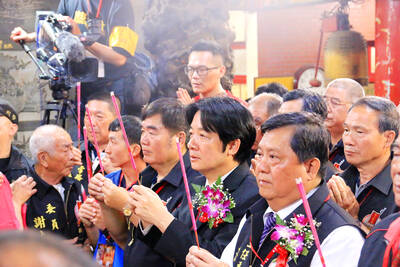Ku Shih-yung (顧世勇) isn’t known for making accessible art. His 2006 solo exhibition at Taipei’s Museum of Contemporary Art (MOCA) included video, bubbles, bells, wax, trumpets and even a life-size dummy attached to a balloon floating above the museum that reportedly prompted a call to police about a possible suicide attempt. The former dean of the College of Visual Arts at Tainan National University of the Arts has penned dense essays on art and theory that reference aspirin-conducive writers like French psychoanalyst Jacques Lacan and philosopher Gilles Deleuze.
Given Ku’s reputation, Oh! Formosa (美哉台灣) at IT Park Gallery (伊通公園) appears deceptively simple. The 49-year-old presents nine large digitally retouched photographs and two smaller unaltered pictures collected from old political magazines and flea markets. The images romanticize “the good-old days” when the sun always shone and beach babes frolicked in the sand.
The average Taiwanese no longer believes the Chinese Nationalist Party’s (KMT) promise of “a brighter tomorrow” and has lost hope in the sullied idealism the Democratic Progressive Party once expounded, Ku says. Many prefer to dwell in a utopian past that may never have existed outside their imagination.
LIVING THE DREAM
Nothing too complicated about that. So is the show a sea change for Ku? Yes and no, he says.
“In the past my art didn’t pay much attention to its place within Taiwan’s context, but now I’m thinking more about it: political, economic and social problems. [I’m examining] the Taiwanese dream from 1949 until now, and I include a little criticism: If we’re going to really face reality, we have to first abandon this dream.”
Ku laughs when I tell him that even my Taiwanese friends find his writing and some of his art hard to understand. He admits his new works are less “artsy,” but says his concept has changed very little. Themes of “peace” and “utopia” in Oh! Formosa can be found in earlier works such as Bubble Man (2006) that hung above MOCA and its antecedent, a 1999-2000 video in which the artist blows a giant bubble that carries him into space, only to burst and send him hurtling back to the earth in a ball of flame.
BREAKING THE MOLD
Ku also stresses a cornerstone of his work that hasn’t changed in 27 years.
After following the conservative curriculum at National Taiwan University of Arts in Banciao, Taipei County, his graduate exhibition consisted simply of photographs of him sitting in a chair, viewed from behind, with nondescript views such as a window or wall in front of him. He called the series Where Do I Sit? and the works showed no reference to the formal techniques he had studied.
“My ‘hand’ in the works I make isn’t important,” he says. “The expression is.”
His statement echoes basic conceptualist dogma that for decades has pitted “idea” art against “formal” art and continues to generate heated intellectual discussion.
Ku’s current show seems an effort by an insider to bring this discussion out of the highfalutin art circle and into the mouths and minds of everyday people. If so, his biggest challenge will be the same that many contemporary artists face: convincing the general public to drop by the gallery and give it a gander.
For those hesitant to make the trip to IT Park for a relatively small show, there are two nearby galleries also worth checking out: VT Art Salon is next door and 50m down the road is the newly opened Sakshi Gallery Taipei — a branch of its Mumbai, India-based namesake — that opens its second show of Indian art on Saturday.

The Democratic Progressive Party (DPP), Chinese Nationalist Party (KMT), and the country’s other political groups dare not offend religious groups, says Chen Lih-ming (陳立民), founder of the Taiwan Anti-Religion Alliance (台灣反宗教者聯盟). “It’s the same in other democracies, of course, but because political struggles in Taiwan are extraordinarily fierce, you’ll see candidates visiting several temples each day ahead of elections. That adds impetus to religion here,” says the retired college lecturer. In Japan’s most recent election, the Liberal Democratic Party lost many votes because of its ties to the Unification Church (“the Moonies”). Chen contrasts the progress made by anti-religion movements in

Last week the State Department made several small changes to its Web information on Taiwan. First, it removed a statement saying that the US “does not support Taiwan independence.” The current statement now reads: “We oppose any unilateral changes to the status quo from either side. We expect cross-strait differences to be resolved by peaceful means, free from coercion, in a manner acceptable to the people on both sides of the Strait.” In 2022 the administration of Joe Biden also removed that verbiage, but after a month of pressure from the People’s Republic of China (PRC), reinstated it. The American

Chinese Nationalist Party (KMT) legislative caucus convener Fu Kun-chi (傅?萁) and some in the deep blue camp seem determined to ensure many of the recall campaigns against their lawmakers succeed. Widely known as the “King of Hualien,” Fu also appears to have become the king of the KMT. In theory, Legislative Speaker Han Kuo-yu (韓國瑜) outranks him, but Han is supposed to be even-handed in negotiations between party caucuses — the Democratic Progressive Party (DPP) says he is not — and Fu has been outright ignoring Han. Party Chairman Eric Chu (朱立倫) isn’t taking the lead on anything while Fu

Feb 24 to March 2 It’s said that the entire nation came to a standstill every time The Scholar Swordsman (雲州大儒俠) appeared on television. Children skipped school, farmers left the fields and workers went home to watch their hero Shih Yen-wen (史艷文) rid the world of evil in the 30-minute daily glove puppetry show. Even those who didn’t speak Hoklo (commonly known as Taiwanese) were hooked. Running from March 2, 1970 until the government banned it in 1974, the show made Shih a household name and breathed new life into the faltering traditional puppetry industry. It wasn’t the first